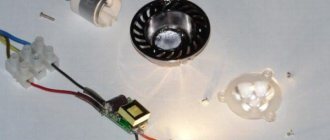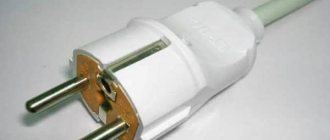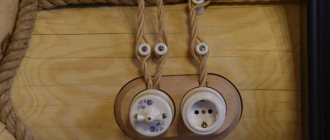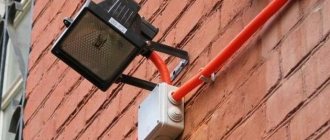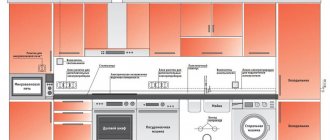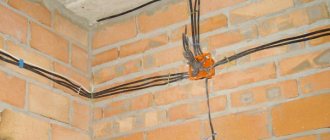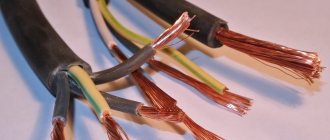The old aluminum wiring was laid several decades ago and is designed for a power consumption of no more than 4 kW. For apartments with modern household appliances, this is unacceptable and can cause fires. In addition, the alloy has a number of distinctive properties, the indicators of which are significantly inferior to those inherent in today's conductive materials.
Outdated old aluminum wiring Source malolikto.ru
Actual service life
Depends solely on the consumer and is determined by how the product was handled.
The actual period may either exceed or be less than that specified in the factory documentation for this product. The actual service life of the product is determined only by its technical condition. The service life of clean electrical equipment (sockets, switches, cords, socket plugs) depends solely on the consumer and his careful handling of the equipment. As for rough electrical work (cable and its connections), the situation is completely different. The fact is that modern electrical panels with the help of automatic circuit breakers protect the line in such a way that any of the automatic circuit breakers (provided they are chosen correctly) will turn off much earlier than the cable not only burns out, but even begins to heat up.
The warranty period for electrical wiring must be at least 10 years. If you, as a customer, are given a warranty of less than 10 years, then you definitely should not contact such “specialists”. Rough electrical installations must withstand at least five renovations and repairs. These updates are carried out every 5-7 years.
Thus, even under the most severe operating conditions, rough electrical equipment should last at least 50 years. After the nominal service life has expired, the network is re-tested under load. If, as a result of such testing, an electrical breakdown of the cable occurs, it is replaced. If the cable has withstood the load, then its operation continues. There are objects where old aluminum wiring has served for more than 70 years.
Modern cables in combination with spring terminals can work for at least 100 years without problems. Currently, the electrical cable is being tested on special test benches.
Test stands are mechanisms that simulate operation in conditions as close as possible to the real ones. Thanks to bench testing, it is possible in a very short time to fairly accurately predict what will happen to the cable after 10, 30, 50 and even 100 years of operation.
Test stands are designed for both cable testing and testing of its connections. Stands are enclosed spaces in which cables are laid in walls, corrugations, or simply in open connections. The cable is subjected to all kinds of stress. Such as may occur under real operating conditions. These are current loads, temperature changes, and humidity changes. A cable that has passed all tests is subject to further use without the need to replace it.
We are often asked the question: “What to do if the apartment has aluminum wiring?” In this article I will try to answer this question.
More about guarantees
Cable manufacturers test their products on special test benches. Checks are carried out under conditions close to real operating conditions. The cables are laid in grooves and corrugations, and the wiring diagram includes connections with terminals and twists. After this, the wiring undergoes “strength tests” - average design loads are applied to the wires, peak loads (both in voltage and current), and the reaction to changes in temperature conditions is checked.
Checks are carried out at the launch of each new series, when introducing new equipment, or when making any changes to the technological process. Cables from different batches from different workshops are selectively checked. Changes in the physical characteristics of the cable, its electrical conductivity, and resistance are monitored. The integrity of the braid is checked to see if it has begun to lose elasticity or collapse. By changing the test loads and constantly measuring the cable characteristics, it is possible to predict its condition after 10, 20, 50 years of operation in various conditions.
Useful tips
It is very important to correctly navigate the basic nuances of installing copper electrical wiring, so here are some tips:
The number of sockets must be selected individually in each case - according to the number and power of electrical appliances in use in a particular room
It is also important to consider the ease of their use so that you don’t have to limit yourself by turning on electrical appliances one at a time. When installing copper wiring, you need to take into account a possible increase in the load on the electrical wiring and the number of sockets in the future, since the electrics are installed for more than one year. It is imperative to have grounding in a residential area. Additionally, copper wiring must be protected by circuit breakers and RCDs
These devices will protect electrical wiring from short circuits, overloads and current leakage. When installing electrical wiring, the main thing is to correctly calculate the cross-section of all electrical wiring lines and choose the right protective devices - the reliability of the installed electrical wiring depends on this. In rooms with high humidity, the cable must be additionally protected with corrugation. Sockets and switches located in such a room must be protected from moisture. Also, lamps in such rooms must be protected from moisture. Despite the many advantages of copper wire, when purchasing, you need to make sure that it is not a TUSH cable, but made in accordance with GOST, otherwise the cores may not meet the specified characteristics. We talked about how to determine the cable cross-section before purchasing in a separate article.
Having made the wiring using a copper cable, you don’t have to worry about any problems arising with it and it will last for decades. Finally, we recommend watching a useful video on the topic of the article:
It will be useful to read:
- How to replace wiring in an apartment
- How to make a wiring diagram
- How to choose a circuit breaker
What material for electrical wiring should you choose for your apartment?
In Soviet times, the use of aluminum electrical wiring in residential premises was common. This was due to the fact that in residential buildings there was no high load on the electrical network due to low power and a small number of electrical appliances. With the development of technology and the advent of a huge variety of powerful electrical appliances that are used at home, the requirements for the quality and materials for electrical cables have increased significantly. In modern realities, wiring made of aluminum material is practically not used, since according to the PUE, electrical wiring in residential premises must be made of copper!
Advantages and disadvantages of aluminum electrical wiring
The main advantages of aluminum electrical wiring are:
- Low mass: the density of aluminum is lower and, accordingly, its mass is lower. When laying simple networks with many cables but light loads, this will be a convenient advantage.
- Low price: aluminum is several times cheaper than copper, so products made from this material are also low in price.
- Resistance to oxidation: in the absence of contact with the environment, it lasts a long time and is not destroyed by oxidation.
The disadvantages of this material include:
- Low electrical conductivity - aluminum has a high resistivity and heats up when electric current passes through it. Therefore, the PUE prohibits the use of such a cable in home networks with a conductor cross-section of less than 16 mm².
- Poor connection - due to oxidation processes and heating/cooling cycles, the connection points of the aluminum cable are gradually destroyed, which can lead to electrical wiring failure or short circuit.
- Fragility of conductors - such cables easily break when heated, which also very often leads to malfunctions.
Advantages and disadvantages of copper electrical wiring
Copper is approved for use and is widely used for electrical wiring in residential and industrial buildings. In terms of electrical characteristics, it surpasses many materials and is second only to silver.
The advantages of copper cables are:
- High electrical and thermal conductivity - copper has a relatively low resistance and effectively conducts electric current, has high efficiency, and does not heat up significantly with the correct cable cross-section.
- Corrosion resistance - copper conductors can operate under any operating and environmental conditions, last a long time and are practically not subject to corrosion.
- Resistance to mechanical stress - copper electrical wiring is strong, ductile and flexible.
- Flexibility and ease of installation - copper conductors are very flexible and can be conveniently mounted at different angles and connected to sockets and switches.
The main disadvantage of copper is its high cost. But you need to understand that when performing such a responsible type of work as wiring installation, safety and durability are very important. Therefore, despite its cost, copper wiring quickly pays for itself and, if used correctly, lasts for a very long time without repairs or malfunctions.
Rules, orders and PUE for aluminum and copper wiring
Aluminum wiring
In accordance with the amendments adopted in 2022, wiring in residential premises can be made from aluminum and copper cables.
However, it is not aluminum wires from the 60-70s that are suitable for use, but modern alloys with some iron content. The main thing is to comply with the requirements given in the table.
| Line name | Smallest cross-section of cables and wires, mm.kv | |
| With cores made of aluminum alloys | With copper wires | |
| Group network lines | 2,5 | 1,5 |
| Distribution network lines for supplying residential premises (risers) | 6 | 4 |
| Lines from floor to apartment boards and to the settlement meter | 4 | 2,5 |
Prohibition of aluminum wiring in the apartment
Old-style aluminum wiring is prohibited from being used due to its recognition as a potential fire hazard.
In accordance with international standards, old-style aluminum wiring is recognized as a potential fire hazard and is therefore prohibited. Several facts that confirm this:
- There have been numerous cases of fires around the world caused by aluminum wiring. As a result, more than a dozen people were killed.
- According to statistics, in apartment buildings and country houses with an aluminum electrical network, the frequency of spontaneous combustion is 55 times higher than the number of fires in rooms with electrical wires made of other materials.
- According to chapter 7.1. PUE. Clause 7.1.34 this type of wiring is permitted for use only in structures that were built before 2001.
- To prevent fire? It is prohibited to connect copper and aluminum wiring, for example by twisting.
Summary and recommendations of electricians
It is better not to connect cables with cores made of different materials. If such fasteners are necessary, you need to choose the right terminal blocks with terminal blocks, and entrust the wiring to professional electricians. Fix the wires to ensure low resistance:
- Welding.
- Soldering with crimping with sleeves.
Electricians advise:
- Install sockets in each room in accordance with the number and power of devices. When installing, take into account the ease of use of the devices so that you do not have to turn on the iron, microwave or washing machine in turn.
- Ground residential premises; any wiring requires compliance with safety precautions.
- Protect the electrical network with circuit breakers, RCDs, so that the device prevents short circuits, overloads or current leakage.
- Carry out installation by calculating the cross-section of the wires and their cross-sectional area.
- In wet rooms, install the cable in corrugation, and additionally install sockets and lamps with protective devices.
There is an undeniable argument that should eliminate doubts about changing conductors. Old aluminum wiring has single insulation, which allows current to leak into the wall.
Nowadays, installation of electrical networks is carried out only with double insulation - cable. In addition, old buildings did not provide for the installation of grounding. It is pointless to protect only the outlet from electrical leaks unless it is replaced with new elements. Electrical equipment must be grounded, a safe wire must be installed along the entire power line, this is the only way to protect the building from fire in the event of a short circuit.
Should I replace the old aluminum wiring in my house with copper or not?
- if the wire is damaged;
- when insulation is damaged due to aging;
- after a fire caused by a malfunction of electrical equipment, for example, due to a short circuit.
The use of copper will help further reduce the risk of accidents. You just need to study the branching diagram and select the wire of the required cross-section. The work is carried out under the supervision of an electrician.
Copper busbars have tangible advantages when used in power supply conditions for individual housing. The only insurmountable obstacle will be the cost, which is 3-4 times higher than the price of a similar aluminum product.
What is the difference
When choosing, physical factors are taken into account:
- specific gravity;
- conductivity, including when heated;
- heat transfer coefficient;
- section.
Some factors are interconnected. For example, with an increase in the cross-section of an aluminum bus, heat transfer increases. This prevents cable deformation.
The disadvantages of aluminum are being corrected when modern technologies are used. For example, the strength of the Al 6101 alloy is higher than that of another type - Al 1350.
Advantages and disadvantages of aluminum wiring
It should be noted right away that electrical wiring made of aluminum is not considered to be of the highest quality or reliable. One way or another, it is this type of system that is installed in most old apartments. This type has the following advantages:
- low weight (aluminum alloys weigh much less than other materials that are used as conductors of electrical energy);
- resistance to corrosion (aluminum instantly oxidizes upon contact with air, forming a protective film on the wire).
Today, aluminum in electrical wiring is often used to create power cables, where the price of the material and its weight are extremely important. A striking example is SIP cables, the cores of which are made of aluminum.
However, in modern new buildings they prefer not to install aluminum-based wiring. This is due to the following disadvantages of this material:
- high degree of fluidity (aluminum stretches well, which is a disadvantage when making screw connections of wires);
- fragility (during long-term use, aluminum cables will break, especially when overheated and under significant loads).
These shortcomings lead to a short service life of the entire installation. The approximate service life of aluminum wiring in an apartment is up to 26 years.
Disadvantages of electrical wiring
The technical requirements of the present time and various regulatory reference books indicate installation only from copper wires due to the increased loads on the electrical network, which aluminum can no longer withstand. In addition, the insulation ages quickly, since conductors made of such material often heat up, exceeding the norm.
Wires tend to oxidize quickly and are not as flexible as copper alloy. This is noticeable in the connections and bends of the wire, which has been repaired more than once. Humidity and poor contacts pose a risk of overheating and fire.
Aluminum wiring was originally designed for 25 years of operation, and in many places this period has long expired and requires urgent replacement. The reasons are:
- Planned electrical installation work regardless of the state of the electrical networks.
- Broken insulation - these places will heat up and the metal will melt.
- Broken conductors - current leaks through the damaged areas.
- Risk of short circuits due to various obvious and hidden disturbances in the electrical network.
- The appearance of burning odors, sparks at points of unreliable connection, at break points, which will lead to a fire.
- Frequent automatic shutdown of protective devices.
- Periodic disconnection of power supplies.
- Installation of powerful household appliances, the operation of which cannot be ensured by old wires.
It is imperative to change the network if a danger arises:
- Fires.
- Life and health of inhabitants.
The technical characteristics of aluminum as a conductor are mainly negative; they exceed all its positive properties:
- Low electrical conductivity.
- High level of oxidation in reaction with air.
- Average service life, after which a fire may occur due to a short circuit in the conductor.
- Weak mechanical strength.
- Due to the fluidity of the metal, when aluminum is stretched, the connections weaken, so they heat up and oxidize.
- Fragility of wires due to long service life, stress and overheating.
The copper conductor left all the negative properties of the aluminum conductor, but took away only one minus - the high cost of the material.
How to extend the life of wiring?
With proper selection of cable diameters, proper quality of materials, and determination of the calculated current load depending on the equipment in the apartment, the wiring will last a long time. Improved cables that are combined with spring terminals are reliable in operation. The qualifications of the electricians who carry out the installation are also important.
The service life is increased by permanent connections when laying aluminum wires - welding, soldering and crimping.
To extend service life, use welding of aluminum electrical wires. The work is carried out using carbon electrodes. The soldering method is performed with special materials and electrician tools: soldering iron, rosin, solders.
Electrical networks after pressure testing are used longer than standard periods. Press pliers, hollow rods and sleeves are required for crimping work.
To increase the service life of the wiring, it is necessary to correctly calculate the size of the cross-section of the wires, which affects the resistance indicator.
The installation of fire protection systems with a control value will protect the installation of electrical wiring from overheating.
For general lines in houses, you need to choose a cable with a rating of 100 mA; in certain areas of lighting sources, a figure of 10 mA is required. If the indicators are exceeded, the USO will turn off automatically.
Compliance with the requirements for the location of switches and sockets will extend the service life. The height of switches in rooms must be at least 1.5 m from the floor. Sockets are mounted at a height of 0.5–0.8 m from the floor surface. In bathrooms, power supply must be supplied from separate transformers.
To increase service life, it is important to follow the rules for laying cable channels. Wires are placed strictly horizontally or vertically
According to the standards, the distance from gas pipes is recommended to be no less than 0.4 m. Horizontal sections are laid at a distance of 150 mm from the ceiling.
Basic operating requirements
If you nevertheless decide to use aluminum wiring in an apartment or private house, consider the following requirements:
- Cross section of at least 16 square meters. mm (we already talked about this, but it wouldn’t hurt to remind you).
- Use clamp contacts (as well as a special lubricant that will prevent contact oxidation and keep contact resistance low).
- Use welding of aluminum electrical wires in distribution boxes (requires a large investment of time and money, so it is rarely used). If you do not carry out the work yourself, monitor the work of electricians in your home and monitor the process to ensure that all technical aspects are adhered to.
It will also be useful for you to know the maximum load on aluminum wires of different sections. We provided all the data in the table:
And remember, regardless of the type of wiring in your home, adhere to fire and electrical safety rules, as well as operating rules. This way you can protect your family and your home from unwanted consequences and accidents. Finally, we recommend watching another useful video
When installing new wiring, the owner of the premises strives to do everything so as not to return to this operation, therefore, when carrying out repairs or during the construction process, he is always interested in how long the service life of the wire is. At the same time, confusion often arises in defining the very concept of service life - designers, cable manufacturers and electricians operate with different numbers. Therefore, first, let’s define the terminology.
Pros of aluminum
This material for laying wiring has certain advantages:
- Ease. Compared to other materials, aluminum wiring has significantly less weight.
- Resistant to corrosion. Aluminum material is less susceptible to destructive effects. When this type of conductor interacts with air, oxidation occurs. But due to the formation of a film on the cable structure, the material is reliably protected from further destruction.
- Price. Aluminum itself is an inexpensive metal. Therefore, it has found wide application in the manufacture of power conductors. Due to its light weight and affordable price, aluminum is considered the best option for laying air inlets.
- Large selection of different types of conductors. If, when renovating a room, it is necessary to install and connect power cables, then you can use SIP-type products. To implement internal wiring, the APBPP, APPV, and APV options are used.
The Chipdip channel spoke about the features of using such cables, as well as their advantages.
Who will this affect first?
According to the law, from now on all developers will be right and fully protected by the above order. So don’t be surprised if, when you move into your new apartment, you find aluminum wiring in it, just like in your grandparents’ houses.
In any project there is always a point where you need to clearly justify costs. This is where copper will begin to lose its position sharply.
The qualifications of the electrician and his lack of the necessary tools will no longer play a role here.
Properties of aluminum wiring
Aluminum wiring is resistant to mechanical stress
Aluminum is not the best option for indoor wiring, but the material has several advantages over its analogues. We are talking about low weight, which greatly simplifies installation work, provided that a large amount of aluminum cable is required. The cost is lower compared to copper. These two main advantages became decisive when choosing types of wiring during the construction of structures in the USSR.
Another important feature of the material is its resistance to corrosion. However, aluminum is highly oxidized when exposed to air. As a result, a film is formed that serves as protection against further damage to the wiring. This film has poor conductivity, which can be attributed to another disadvantage.
- When oxidized, copper does not lose its conductive properties.
- Has a long service life.
- The material is more resistant to mechanical stress, for example, bending, twisting, etc.
During oxidation, films are formed in both cases, but each has different conductive properties.
Aluminum fluidity
Aluminum is several times softer than copper
First of all, you need to know about the physical and chemical properties of aluminum. The substance belongs to the group of fluid metals; it is several times softer than copper. This is a significant drawback, since homeowners need to regularly check and, if necessary, tighten all screw contact points, for example, in sockets, automatic machines and terminal blocks. This is very inconvenient if there are 10 or more sockets in the house, which need to be disassembled, tightened and installed in their original place every six months.
Flexibility and fragility
The second feature of aluminum cores is fragility and fragility. If you bend them several times, they will break off without much effort. It takes a lot of effort to deform copper.
Connecting aluminum to machines
Aluminum and copper are not galvanically compatible
The third feature of the material is the contacts of switching equipment. For RCDs, switches, voltage relays, contactors, terminal blocks and starters, they are initially made of copper or brass.
If you directly connect brass-aluminum = copper-aluminum contacts, a galvanic couple is formed, accompanied by strong heating of the junction and the formation of oxides.
Core cross-section
Another feature of aluminum wiring is the need to increase the cross-section of the wiring strands. If previously it was enough to use cables with copper conductors of size 2.5 mm2, now there is a need to lay at least 4 mm2.
Core cross-section
The fifth reason is an increase in the cross-section of the wiring strands. Where previously a cable with 2.5mm2 copper cores was sufficient, now you will have to lay 4mm2 aluminum cores.
And this, by the way, is all the socket groups in the apartment.
Nowadays the tendency to carry out all repairs without junction boxes has become very popular. In this case, all switching and connections are made directly in the socket boxes. Imagine how you will do this if we are not talking about two 2.5 mm2 cores, but about three, four or five taps of 4 mm2 each.
For example, the outer diameter of the AVVG 3*4mm2 cable is 14.8mm, and the outer diameter of the VVGng 3*2.5mm2 copper cable is 10.2mm. That is, on the cable alone there will be an increase in occupied space by 50%.
Actual service life
It is this indicator that is most interesting to the owner of the premises. At the same time, in practice, this is where the biggest difference is observed, since the actual service life of electrical wires depends on a lot of factors that were listed just above. If the wiring is done correctly, the installation is carried out in compliance with all the requirements of electrical construction norms and regulations, the load power does not exceed the design value, and so on, then the wiring can last a hundred years. But if at least one of the many conditions is not met, the service life is shortened.
Another example: the cable powers a triple outlet in the kitchen, to which a microwave oven, coffee maker and electric kettle are connected. Under normal conditions, these devices almost never operate simultaneously. But all of them can be included, albeit for a short time, when preparing or holding a large family celebration. Even a short-term peak load will reduce the service life of electrical wiring.
Overheating is a separate issue. It can be caused not only by excess load, but also by external factors. For example, after installing cable lines, a fireplace was installed in the apartment and as a result, some wire ended up in close proximity to the chimney. Constant heating, at worst, will lead to damage to the braid (and, naturally, to a short circuit); at best, to a change in physical properties, which will reduce its service life.
This is one of the first questions raised when replacing wiring as part of a major renovation in a residential building. In general, the answer to this is most often unambiguous - copper.
There are enough reasons for this - copper has lower resistivity, higher electrical conductivity, and almost twice the maximum power load for the same cross-sectional area. And the service life of copper wires is longer - 20-25 years (nominal) versus 15-20 for aluminum. But there are some nuances.
If something changes, then everything will change completely. Firstly, the connection between the copper and aluminum core is a weak point in the wiring
even when using a terminal made of a third metal (direct twisting in this case is generally unacceptable, since copper and aluminum form a galvanic couple). Secondly, a partial replacement in order to increase wiring in some loaded area (for example, in a kitchen with a full set of household appliances) will not yield anything. A copper cable laid in the walls directly in the kitchen can actually cope with the increased load on its own, but an aluminum cable running from the apartment panel to the junction box cannot.
Another point worthy of attention is the economic feasibility of such a replacement. A copper core is still more expensive than an aluminum one, and if the house is not “packed” so much that the wiring really requires reinforcement, there is no point in changing it just because “aluminum is out of fashion.”
So, if the house is not crammed with household appliances, and the repair budget is limited, then you can change (if there is such a need at all) to aluminum. The only caveat is that in this case it will be necessary to carry out some kind of prophylaxis every two to three years. Its essence is to tighten the clamping screws in switches and sockets. Aluminum is plastic, the force exerted by the screw (or the contact pad pressed by it) leads to its deformation, the contact weakens over time, and poor contact is the most common cause of fires due to electrical wiring.
I think all owners of apartments and houses sooner or later are faced with the question of replacing electrical wiring, its rational use, advantages, disadvantages, service life, and so on. Today we will try to explain to our readers as easily and clearly as possible all the pros and cons of using aluminum wiring, and we will also figure out whether it is worth changing it to copper or not.
A few important facts
So, to let you know why aluminum wiring is dangerous, we recommend that you familiarize yourself with the following facts:
- In accordance with international standards, aluminum electrical wiring has long been recognized as a potential fire hazard.
- Cases that have caused death have been recorded more than once.
- In houses and apartments where an aluminum electrical network was used, fire cases were recorded 55 times more than with other electrical wiring.
- This type of wiring is still permitted, but only on a temporary basis.
- To prevent fire, do not connect copper and aluminum wiring together.
All these factors can cause a fire in the home network and, as a result, a fire in a house or apartment. You can clearly see how dangerous this type of electrical wiring is in the video below:
Example of a dangerous situation
Is it worth changing aluminum wiring in an apartment or not?
In old houses, where aluminum wiring has rotted and crumbles when you touch it, there can be only one answer - it is urgently necessary to replace it with copper wiring. Of course there will be costs, but with old electrical wiring you can lose much more.
Aluminum wiring in the apartment
Sometimes aluminum wiring can be in satisfactory condition when it has been used in dry areas and has not overheated. In terms of composition, Soviet aluminum complied with GOST, which could withstand repeated overloads and did not have the same fragility as today's Chinese aluminum, and Russian aluminum as well.
It took a lot of effort to break Soviet aluminum. The cross-section of the aluminum wire of that time corresponded to GOST, not like now, a wire cross-section of 2 mm² is called 2.5 mm², etc. In addition, the aluminum wire contains additives that reduce its cost, but do not improve its characteristics in any way, rather the opposite.
Another paradox: if previously the permissible rated current of an aluminum wire with a cross-section of 1 mm² was equal to 4 A, now it has become, according to the new GOST, equal to 7 A (for small sections). Despite the fact that the quality of the aluminum wire has deteriorated and the cross-section has been reduced.
Dependence of rated current on the cross-section of aluminum wires
If the old aluminum wiring is well preserved, and the number of household appliances has increased significantly, that is, the load on the electrical network in the house has increased, it can be recommended not to touch the old aluminum wiring in the apartment, but to install a priority relay.
With this load control relay, you can use 2 times more power from household appliances without upgrading the electrical wiring, due to the sequential connection of the devices. If you do not have an electrical panel in your apartment, then you need to install it. Do not install a priority relay in the driveway panel. You can also install an introductory automatic switch in the electrical panel instead of plugs in the access panel.
Another option can be used with a small alteration of the electrical wiring in the apartment, if the aluminum wires are in good condition. The main load current falls on household appliances such as a washing machine, boiler, microwave oven, i.e. the kitchen bears the heaviest load. In this case, you can replace the aluminum wires with a copper cable only in the kitchen.
The cost of such electrical wiring upgrades will be low. From the access switchboard you need to run a copper cable with a calculated cross-section for the load to the meter in the apartment and install a panel with an input machine, a machine for a washing machine, and sockets. It is also advisable to install an RCD, a voltage relay and a priority relay.
RCD is necessary for safety. We definitely install a voltage relay, because you have old electrical wiring and the probability of a zero break is very high. It is cheaper to install a voltage relay than to purchase expensive household appliances again. In the entrance electrical panel, you need to replace all the aluminum wires with a copper cable and connect it to the terminals of the input circuit breaker of the new apartment panel.
Grounding (if it is not available) can be taken from the electrical panel housing in the entrance with a bolted connection. It is better to run a separate copper cable from the apartment panel for all kitchen sockets. If there is an electric stove, the cable must also be separate, from the meter through the machine to the stove socket. The kitchen lighting can be left untouched.
Installation of wiring along the baseboard
A separate automatic switch is installed for the air conditioner in the rooms, and a copper cable is led from the apartment panel through a plastic cable channel to the baseboard. Modern baseboards have channels for electrical wiring. The cable is brought along the baseboard to the socket location, and raised to the socket through the cable channel.
Such an upgrade will cost you much less than replacing electrical wiring throughout the apartment.
Storage and operating conditions
The classic performance characteristics of such a cable lie in the temperature range from −50 to 70 degrees. If the temperature is about 80-90, then the cable can serve for a short period of time. Irreversible damage begins within temperatures of +130 degrees.
Note! When buying VVG, it is advisable to choose the material with the latest production date. This will help avoid problems due to long storage
This mainly applies to stranded and thin wires, which are more prone to corrosion.
It must be stored in a dry place, with humidity not exceeding 85 degrees. The wire must be wound and placed in a special case. Moisture on the product will reduce its service life.
Cable products at the factory
Some generally accepted GOST standards for electrical networks
The location of electrical networks in the house must comply with certain norms and standards. Below is a list of some provisions of the Interstate Standards (GOST) that must be complied with.
- Meters, sockets and junction boxes should be located in easily accessible places;
- The height of sockets is 30 cm, switches are 90 cm;
- If there are any metal objects or elements nearby, the sockets should be placed 50 cm from them;
- Installation of sockets in the toilet is possible only if they are equipped with water protection;
- The required number of sockets in the kitchen is 3, in other living areas - 1 socket (socket per 6 sq.m.).
Rules for different types of wiring
For each type of electrical installation, you must adhere to certain rules.
The closed type is the safest, since when used, all wires are hidden and protected from mechanical stress. But it is a rather long and labor-intensive preparation procedure, namely, you need to at least prepare the “tunnels” in the wall. This method is good to use if your walls are lined with plasterboard, then to attach the wires it is enough to place the wiring behind the sheet.
Open wiring is the easiest way to lay wires. The advantage of this method is the ease of replacing or repairing the cable if damaged. In most cases, it is used in utility rooms.
The combined method of laying electrical wiring combines a closed and open laying, which simplifies the task, but nevertheless it has its own standards. Boxes for laying lines are chosen mainly from plastic; they are more practical and quite reliable. There must be free space in the box to accommodate all the wires.
It is necessary to use special flat wires APRV, APR. In the presence of flammable walls, asbestos insulation was previously used (thickness according to standards should not be less than 0.5 cm). However, today there are other safe materials with excellent insulating properties. The insulating layer is located between the wall and the wires, and in the event of a short circuit it prevents the wall from igniting.
Features of connecting wires on the street
When laying cables outdoors, it is necessary to take into account the negative impact of external factors on the cable line. Icing and exposure to rain will reduce the service life of wires. Therefore, installation and connection work must be carried out in sealed and closed structures. The wiring will be as resistant to low temperatures and sun rays as possible. If connections are made on poles or on roofs, it is recommended to use special piercing clamps.
The Electrician's Tips channel spoke in detail about the implementation of a hermetic connection of two conductors.
Disadvantages of aluminum wires
The disadvantage of aluminum wiring in an apartment building is the “fluidity” of the alloy and rapid oxidation. It is necessary to regularly tighten screw connections in switches and sockets, since connections with other metals and substances can deteriorate.
Oxidation of wires causes an increase in resistance at the joints, leading to heating of the wires even under low loads. Cracks may form at the bends of the cables, and urgent replacement of the electrical wiring will be required.
In apartment buildings, the number of powerful appliances (washing machines, electric ovens) is growing. Household appliances have a lot of power, and when using old wiring, there is a risk of failure of the power supply system and a fire.
The material is more fragile than copper wiring, so aluminum cables can break when pulled. Among the disadvantages is the tendency to heat up due to high resistivity values. When the wires are frequently heated and cooled, the contact connections become loose.
Lighting. How do you know when it’s time to change everything?
It is necessary to pay attention to lighting fixtures: old chandeliers, sconces, lamps. The weak point of old lighting devices is the cartridges! Over time, the plastic of the cartridges dries out and bursts, the contacts overheat and oxidize, hence all the ensuing problems. Often, due to such sockets, light bulbs explode, or the base is left inside the socket. Replacing sockets in old chandeliers is not a cheap pleasure, as it is a very painstaking job and requires quite a lot of time. It is often easier and cheaper to buy a new lighting fixture.
Cartridge
Be careful with electric current! Don't have the funds to completely replace the wiring? - Do it at least partially. Any improvement in wiring is additional insurance for your safety, which significantly reduces the likelihood of any problems with wiring and will significantly reduce energy costs.
Wiring life
When installing electrical networks, it is important to determine the service life of aluminum wiring. Manufacturers, building designers and electricians use different parameters for operating electrical systems
The service life of wires can be nominal, warranty, or actual. The relationship between different indicators will help plan the replacement of electrical wiring in order to prevent drying out of connections, cable fragility and the risk of short circuits.
Nominal
When calculating the nominal indicator, factors of product performance are taken into account. There are lower and upper limits for service life. Indicators are important for theoretical justification of building projects and are used by designers when developing electrical wiring systems.
When determining the nominal designation, the time during which the cables will operate properly if the operating rules are observed is taken into account. Cables that operate at temperatures of –50…+50 °C have a load of no more than 660 V and a nominal service life of 25–30 years.
Electrical cables must be tested after completion of the rated service life. If failures occur, you will need to change the wiring when renovating the apartment.
Warranty
The warranty period for electrical wiring made of aluminum alloys is determined by the manufacturer. This is the period within which the supplier ensures that the cable’s performance characteristics are maintained.
If cable systems malfunction during the warranty period, the manufacturer is obliged to replace the failed wires free of charge. However, the manufacturer’s obligations apply only if operating standards are met and electrical wiring is installed correctly. Also, the seller must ensure proper storage conditions for the goods before transfer to the buyer and safe transportation.
You can obtain a replacement cable by confirming qualified wiring installation, which must be performed by licensed professionals. If the wiring system is overheated or insufficiently supplied with electricity, the manufacturer's obligations may be void.
The warranty shelf life is determined by the manufacturer during testing on benches. The cables are laid in grooves and supplemented with terminals and twists. Then the wiring is tested for strength, subjecting it to average design loads and peak overloads. The reaction to temperature changes and compliance with GOST are checked. Manufacturers guarantee the safety of the cable for 5–10 years.
Actual
The actual service life of electrical wiring is influenced by many operating factors. With proper wiring, qualified installation taking into account SNiP standards for laying electrical devices, and maintaining optimal load power, the period of use exceeds the rated one several times. But failure to comply with even one or two requirements can reduce the operating time of the electrical wiring.
The period of operation depends on the proper selection of safety devices. The shutdown indicator must be lower than the maximum possible heating temperature of the wires. For a solid wire with a cross section of 2.5 sq. mm, capable of withstanding current up to 25 A, a device that will turn off at 16 A is suitable.
Overheating of the electrical wiring system may be caused by excessive load. Even a short-term activation of a coffee maker, electric kettle, or microwave oven in the room will lead to peak overheating, which reduces the service life of the cables. Possible influence of external factors - location close to electric furnaces, chimneys.
The actual service life of aluminum electrical wiring in residential buildings is determined by the technical condition of the wires and operating conditions. The condition of clean electrical equipment, which includes cords, sockets, and switches, depends on careful handling of the equipment. Rough electrics (connections, cables) are affected by the flow of electricity into the network.
Benefits of Copper Wiring
Copper electrical wiring is resistant to bending, does not break off, during long-term use it has better electrical conductivity, oxidation of the end wires does not affect performance in any way. It is worth noting that according to the new rules for construction and installation work, only copper electrical wiring is laid, aluminum wiring is not taken into account due to the above-mentioned shortcomings.
Not everyone can carry out a complex reconstruction of electrical wiring, complete or partial, on their own. If you are not able to carry out the transformation, I do not recommend inviting the first electrician you come across. To properly replace electrical wiring, hire a competent electrician.
When installing new wiring, the owner of the premises strives to do everything so as not to return to this operation, therefore, when carrying out repairs or during the construction process, he is always interested in how long the service life of the wire is. At the same time, confusion often arises in defining the very concept of service life - designers, cable manufacturers and electricians operate with different numbers. Therefore, first, let’s define the terminology.
The role of the management company in replacing wiring
Major repairs are carried out using funds received monthly from the residents of the building to the management company. Accordingly, the management company is responsible for competent, professional installation of electrical wiring in the entrance. The frequency of major renovations varies from house to house. The monthly payment for it also varies in different regions (from 1.38 rubles per sq.m. to 15 rubles). If necessary, residents may decide to charge additional fees.
In conclusion, it must be said that replacing wiring in the entrance of an apartment building is a very serious matter that should be performed exclusively by professionals. Pay close attention to this work and monitor compliance with regulations, compliance with standards and selection of personnel for the safety of yourself and your loved ones in the future. All work must comply with existing standards and requirements in order to save residents from worrying about the possible unpleasant consequences of poor installation for many years to come.
